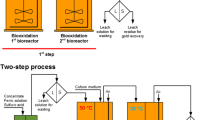Abstract
A technology for tank biooxidation of refractory gold-bearing concentrate under variable temperature conditions has been improved: the temperature of the first of two stages was changed from 30°C to 34–36°C. Gold in this concentrate is mainly associated with sulfide minerals: arsenopyrite and pyrite, which underlies a low gold recovery (16.68%) as a result of cyanidation. To resolve the problem, an association of mesophilic acidophilic chemolithotrophic microorganisms and moderately thermophilic bacteria of the Sulfobacillus genus were used for the concentrate oxidation. The composition of the used microbial association was studied; it was shown that it depends upon temperature: at 42°C, the population of the mesophilic thiobacteria decreased, whereas that of thermophilic sulfobacilli enhanced as compared to 36°C. The accepted scheme of the process ensures a high extent of gold recovery (94.6%) within a short space of time for biooxidation (96 h).
Similar content being viewed by others
Abbreviations
- AAS:
-
atomic absorption spectrometry
- AE:
-
atomic emission spectrometry
- BO:
-
biooxidation
- ICP:
-
inductively coupled plasm
- MSA:
-
mass spectrometric analysis
- S:L:
-
hard fraction mass of pulp (ore concentrate) to liquid fraction mass of pulp (in this case it is the nutrient saline) ratio
References
Van Aswegen, P.C., van Niekerk, J., and Olivier, W., in Bio-Mining, Rawlings, D.E. and Johnson, B.D., Eds., Berlin: Springer, 2007, pp. 1–35.
Xie, J.Y., Gao, J.C., Jin, S.B., and Han, X.G., in Proc. XXIV IMPC, Geng Jianyl, Ed., Bejing: Science Press, 2008, pp. 2737–2740.
Karavaiko, G.I., Smolskaja, L.S., Golyshyna, O.K., Jagovkina, M.A., and Egorova, E.Y., Fuel Proc. Technol., 1994, vol. 40, pp. 151–165.
Tsaplina, I.A., Bogdanova, T.I., Sayakin, D.D., and Karavaiko, G.I., Mikrobiologiya, 1991, vol. 60, no. 6, pp. 34–40.
Zakharchuk, L.M., Tsaplina, I.A., Krasil'nikova, E.N., Bogdanova, T.I., and Karavaiko, G.I., Mikrobiologiya, 1994, vol. 63, no. 4, pp. 573–580.
Norris, P.R., Brierley, J.A., and Kelly, D.P., FEMS Microbiol. Letts., 1980, vol. 7, pp. 119–122.
Melamud, V.S., Pivovarova, T.A., Kondrat'eva, T.F., and Karavaiko, G.I., Appl. Biochem. Microbiol., 1999, vol. 35, no. 2, pp. 182–189.
Sovmen, V.K. and Gus'kov, V.N., RF Patent No. 2256712 C22B11/00, 3/18 (2005).
Zaulochnyi, P.A., Sedel'nikova, G.V., Savari, E.E., and Kim, D.Kh., in Tez. 5 Mosk. Mezhdunar. Kongr. “Biotekhnologiya: sostoyanie i perspektivy razvitiya” (Abstr. 5th Moscow Int. Congr. “Biotechnology: State and Development Prospects”), Moscow: ZAO Ekspobiokhim-tekhnologii, 2009, part 2, pp. 326–327.
Silverman, M.P. and Lundgren, D.C., J. Bacteriol., 1959, vol. 77, pp. 642–647.
Reznikov, A.A., Mulikovskaya, E.P. and Sokolov, I.Yu., Metody analiza prirodnykh vod (Analytical Methods for Natural Waters), Moscow: Nedra, 1970.
Surovskaya, I.A., Titov, V.I., Brodskaya, V.M., Vasil'ev, P.I., Lipshits, B.M., and Elentukh, B.M., Tekhnicheskii analiz tsvetnoi metallurgii (Technical Analysis of Nonferrous Metallurgy), Moscow: Metallurgizdat, 1957.
Filippova, N.A., Fazovyi analiz rud i produktov ikh pererabotki (Phase Analysis of Ores and Their Processed Product), Moscow: Khimiya, 1975.
Zelenov, V.I., Metodika issledovaniya zolotosoderzhashchikh rud (Study Method for Gold Ores), Moscow: Nedra, 1978.
Karavaiko, G.I., Biogeotekhnologiya metallov. Prakticheskoe rukovodstvo (Biogeotechnology of Metals: A Practical Guide), Moscow: Tsentr mezhdunar. proektov GNKT, 1989.
Melamud, V.S. and Pivovarova, T.A., Appl. Biochem. Microbiol., 1998, vol. 34, no. 3, pp. 309–315.
Golyshina O.V., Pivovarova, T.A., Karavaiko, G.I., Kondrat'eva, T.F., Moore, E.R.B., Abraham, W., Lunsdorf, H., Timmis, K.N., Yakimov, M.M., and Golyshin, P.N., Int. J. System. Evol. Microbiol., 2000, vol. 50, pp. 997–1006.
Author information
Authors and Affiliations
Corresponding author
Additional information
Original Russian Text © P.A. Zaulochnyi, A.G. Bulaev, E.E. Savari, T.A. Pivovarova, T.F. Kondratieva, G.V. Sedelnikova, 2011, published in Biotekhnologiya, 2011, No. 3, pp. 1–10.
Rights and permissions
About this article
Cite this article
Zaulochnyi, P.A., Bulaev, A.G., Savari, E.E. et al. Two-stage process of bacterial-chemical oxidation of refractory pyrite-arsenopyrite gold-bearing concentrate. Appl Biochem Microbiol 47, 833–840 (2011). https://doi.org/10.1134/S0003683811090080
Received:
Published:
Issue Date:
DOI: https://doi.org/10.1134/S0003683811090080




